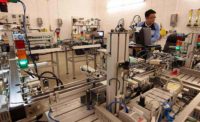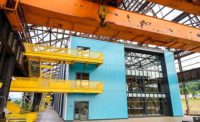Assembly Lines
‘Smart Manufacturing 5.0’ Focuses on Human-Centric Factories

Manufacturers need to start transitioning from Industry 4.0 to Industry 5.0.
Illustration courtesy Info-Tech Research Group
TORONTO—Manufacturers need to start transitioning from Industry 4.0 to Industry 5.0, according to a new report from Info-Tech Research Group. Like Industry 4.0, Industry 5.0 originated in Europe. It focuses on human-centric processes that place the well-being of people at the center of manufacturing activity.
According to Info-Tech, companies should adopt Smart Manufacturing 5.0, which combines the innovations of Industry 4.0 with a focus on human-centric, resilient and sustainable practices.
“While many organizations are still struggling to achieve Industry 4.0, Smart Manufacturing 5.0 offers a more efficient approach to modernizing production, enhancing workforce skills and overcoming legacy system obstacles,” says Kevin Tucker, research advisory practice lead at Info-Tech Research Group.
“Throughout the evolution of industry from 1.0 to 4.0, we have seen major changes that have significantly impacted the strategic decisions being made by organizations,” explains Tucker. “Most [large manufacturers] have now achieved some level of implementation that includes Industry 4.0 technologies, with cloud services being the most widely adopted.
“Now that we are in the midst of the next evolution…integrating technology and people has become crucial,” claims Tucker. “Embracing Smart Manufacturing 5.0 enables manufacturers to stay competitive, meet evolving market demands and drive long-term growth.
“Organizations must embrace Industry 4.0 tools and technologies and begin to focus on Smart Manufacturing 5.0 if they hope to achieve exponential growth or protect their market share from competitors who are doing so,” says Tucker.
“A more rapid adoption of Smart Manufacturing 5.0 and Industry 5.0 than of Industry 4.0 is anticipated,” notes Tucker. “[That is] due to the widespread acceptance of the integration of artificial intelligence, machine learning and humans as an essential component of any successful business model that prioritizes sustainability, quality, efficiency and the well-being of employees.”
Tucker advocates for a strategic approach, highlighting the importance of addressing legacy system integration, workforce skill development and data management. He says the goal of Smart Manufacturing 5.0 is to combine the best of Industry 4.0 with the attributes of Industry 5.0, creating factories that are safe, mass-customizable, collaborative, cognitive and environmentally friendly.
However, Tucker warns that achieving Smart Manufacturing 5.0 requires more than just integrating advanced technologies. “It demands a strategic transformation of manufacturing practices,” he points out. “By adopting these strategies, manufacturers can achieve greater efficiency, enhance product quality and promote sustainable operations.
“This forward-thinking approach enables manufacturers to meet current market demands and adapt to future challenges effectively,” notes Tucker. “Investing in Smart Manufacturing 5.0 and following this structured framework and principles [will ensure] that manufacturers can deliver innovative, high-quality products while maintaining a strong competitive edge in the dynamic industrial landscape.”Looking for a reprint of this article?
From high-res PDFs to custom plaques, order your copy today!






